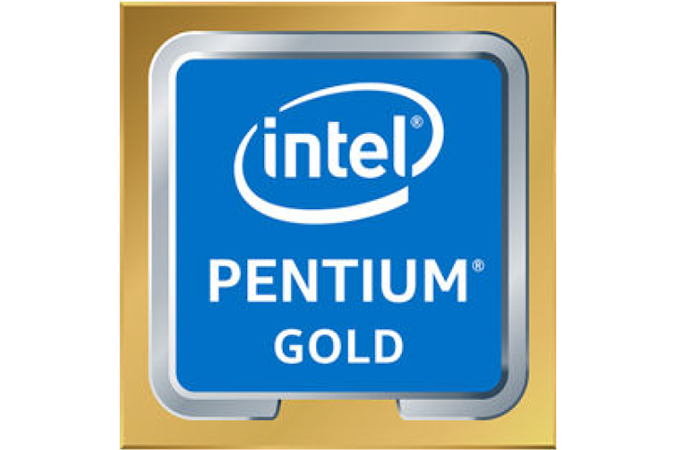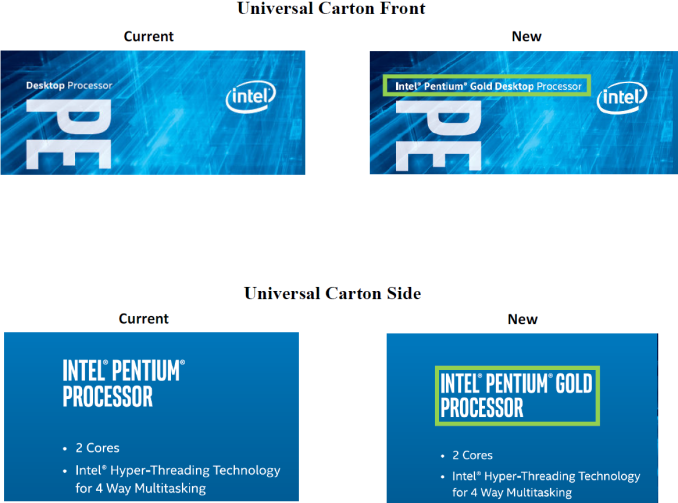Intel Rebrands Kaby Lake Pentiums to Pentium Gold
by Anton Shilov & Joe Shields on October 12, 2017 2:30 PM EST- Posted in
- CPUs
- Intel
- Pentium
- Kaby Lake
- Apollo Lake
- Pentium Gold

Intel has announced plans to rebrand its current generation Pentium processors, and future generations, to 'Pentium Gold' chips. The rebranding reflects Intel’s intention to position the latest Pentium CPUs above the previous generation parts.
Starting from November 2nd, Intel’s boxed Pentium G4560, G4600, and G4620 processors will carry the Pentium Gold brand. These parts were launched in Q1 2017, and are dual-core CPUs with Hyper-Threading technology and an improved integrated GPU.
| General Specifications of Intel's Pentium G-Series Processors | |||||||||||||
| Kaby Lake | Skylake | ||||||||||||
| Cores | Freq. | L3 | iGPU | TDP | Cores | Freq. | L3 | iGPU | TDP | ||||
| Gold G4620 | 2/4 | 3.7GHz | 3MB | i630 | 51W | G4520 | 2/2 | 3.6GHz | 3MB | i530 | 51W | ||
| Gold G4600 | 3.6GHz | G4500 | 3.5GHz | ||||||||||
| Gold G4560 | 3.5GHz | i610 | 54W | G4400 | 3.3GHz | i510 | 54W | ||||||
| G4600T | 3.0GHz | i630 | 35W | G4500T | 3.0GHz | i530 | 35W | ||||||
| G4560T | 2.9GHz | i610 | G4400T | 2.9GHz | i510 | ||||||||
| HD Graphics 610: 12 EUs at 900 - 1100 MHz HD Graphics 630: 24 EUs at 1000 - 1150 MHz |
HD Graphics 510: 12 EUs at 950 MHz HD Graphics 530: 24 EUs at 1150 MHz |
||||||||||||
With the name changes also comes a slight branding and retail packaging update. The first is with their “Piggyback label” (included sticker attached to the instructions), which changes from the ‘PCB’ die map as a background to gold. Instead of saying Pentium inside, it now says Pentium Gold with the Intel name above it.
The outside of the retail packaging carton some changes are made as well. Where it used to simply say “Desktop Processor” now says “Intel Pentium Gold Desktop Processor.”
There are unofficial reports claiming that Intel is also preparing Pentium Silver products, thus splitting the desktop Pentium lineup into two groups. The Pentium Gold family evidently consists of the mainstream desktop (MSDT) processors based on the high-performance Core-branded microarchitecture. According to some reports, the Pentium Silver lineup will use the ultra-low power (ULP) codenamed Gemini Lake microarchitecture, but we cannot confirm this independently.
Source: Intel











61 Comments
View All Comments
privater - Thursday, October 12, 2017 - link
Great, next one might Rose Gold?BedfordTim - Thursday, October 12, 2017 - link
The next one is Pentium Silver which represents an Atom based Pentium. Unusually there is a bit of logic to Intel's naming as the metal represents the architecture.ddriver - Thursday, October 12, 2017 - link
What logic? Atom is trash, silver is fairly valuable.iwod - Thursday, October 12, 2017 - link
LoL, This is Gold.Foeketijn - Friday, October 13, 2017 - link
Recent Atoms are not so bad. Not compared to the 410 530 etc. They are no Xeon D, but also not casio calculator material anymore.IntelUser2000 - Friday, October 13, 2017 - link
Yea, they are becoming fairly good CPUs. The Silvermont core in the 22nm Atoms are ~50% faster per clock than the Bonnell/Saltwell cores in the 410/530 ones.The Goldmont core in current generation Atom-based cores are an additional 30% faster than Silvermont.
The Goldmont Plus core in the upcoming Geminilake is said to be an additional 30% faster, having 4-wide issue.
Based on Anand Bench comparisons, that would put Geminilake on the class of Westmere cores. Of course Geminilake doesn't have Hyperthreading, but it means it would have caught up with Westmere cores in perf/clock/thread.
serendip - Friday, October 13, 2017 - link
I'm crazy enough to use a Cherry Trail Atom tablet (14nm Airmont core) as my main work machine. It's fine for documents, just don't try doing big builds on it. I had a 22nm Silvermont Windows tablet that was surprisingly decent to use, although it had a much lower res screen.Too bad Goldmont-based tablet platforms got killed last year. Intel really needs a 2W TDP tablet platform, stuffing 4W Apollo Lake chips into tablets results in atrocious battery life. And whoever does Intel's atrocious naming schemes should be shot.
someonesomewherelse - Saturday, October 14, 2017 - link
Not since Baytrail. I have one of those cheap 200 eur Windows tablets with a z3775 (quad core, 1.46GHz base / 2.4 GHz turbo (all cores) and the cpu is pretty good. I mean it's no Threadripper, but for the price I can't complain. It can turbo indefinitely, the battery still lasts for a day of light use as long as you have the display brightness set a few steps below max (almost as bright as max, massively lower power consumption and it's plenty fast for the money (it even has quicksync so you can transcode video extremely quickly). The iGPU is a bit slow and if you are watching a 1080p video on the external display you can't do much on the internal.What kills it is the stupid 2GB ram max... it should have at least 8 GB, the slow internal emmc (~20 MB/s in optimal conditions), even slower sd card reader (~10 MB/s in optimal conditons) and the whole 32 bit uefi/no usable linux drivers garbage.
serendip - Saturday, October 14, 2017 - link
Asus Transformer something? Very few devices used the Z3775. Most used the 3740 with a slower 1.8 GHz turbo. I loved my Dell Venue 8 Pro to bits even with the stupid 2 GB RAM limit and the insane 32-bit UEFI.I've switched to a cheap Chinese brand tablet with Cherry Trail, 4 GB RAM and a 2k hi-dpi screen. That screen limits battery life to 9 hours average and the iGPU can't handle all those pixels without sometimes choking, although 1080p x265 decoding is buttery smooth.
someonesomewherelse - Saturday, October 14, 2017 - link
Yeah, TF100A or something like that. What's really funny is that for the same amount of money I paid for it back in 2014 I can't get anything significantly better (if at all) in 2017.